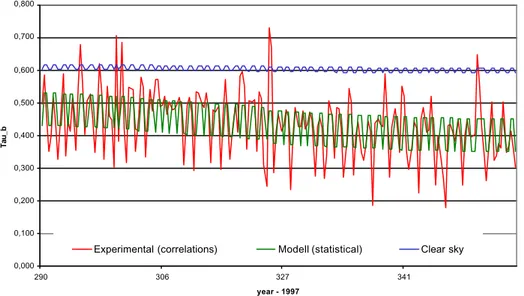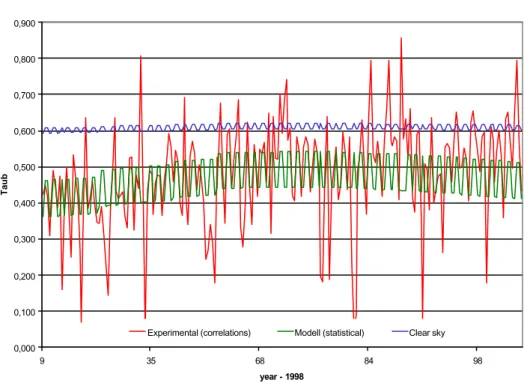Adjustment of the Clear Sky Coefficients for the Transmission of Solar
Radiation under the Ambient Conditions in Fortaleza
Maria Eugênia Vieira da Silva, Alex Sandro de Araújo, and Marcelo Ricardo Queiroz Medeiros. Universidade Federal do Ceara, Laboratório de Energia Solar Aplicada
Bloco 714, Campus do Pici s/n, Pici, Fortaleza 60190-080 BRAZIL E-mail: eugenia@les.ufc.br
Abstract
This research article presents the transmittance of direct solar radiation calculated using the clear sky model and measurements made in the city of Fortaleza. To estimate the clear sky coefficients needed in the model, correlations available in the literature for the ratio of an hour’s radiation to the standard clear sky radiation for that hour were used. The calculated values for the transmittance to direct solar radiation and the clear sky model were used in a non-linear statistical procedure to estimate the coefficients needed. The data used in the statistical procedure were for the year 1997 and, even though the new coefficients represented well the direct transmittance in the year 1997 and 1998, a definite change cannot be suggested at this time, as data for other years are needed.
1. INTRODUCTION
The hourly and also instantaneous distribution of solar radiation is needed in various applications in the field of solar energy. The most reliable predictions of solar system performance are based on pyranometer data taken over a period of year at the place of interest. In many instances, however, available solar radiation data that have been collected are presented as a sum of integrated daily values. There are models to estimate hourly values using daily values and also information about the direct and the diffuse solar radiation transmittance. Hottel [1976] presented a model, with good accuracy and simple use, to estimate the clear-day transmittance of direct solar radiation through clear sky. In this general model, the transmittance to direct solar radiation is calculated using constants and corrections for four different climate zones in the globe. The purpose of this work is to verify and adjust these constants for the semi-arid climate of the city of Fortaleza in the northeast coast of Brazil.
Daily values of global solar radiation on a horizontal surface have been collected since the 1970’s by the Weather Station at the Federal University of Ceara [UFC]. Not all measured values have been integrated and published in the literature. Vieira and Rocha (1996) presented a compilation of these available data, including daily global solar radiation per square meter on horizontal plane from July of 1972 to June of 1989. From 1997 to 1999, instantaneous direct and global solar radiation data have been collected at the Applied Solar Energy Laboratory of the Federal University of Ceara. These data have been used to estimate the constants used in the clear sky radiation model presented by Hottel [1976] to determine the transmittance to direct solar radiation. Using just one year of data is not sufficient to suggest definite changes in these coefficients but it can, at least, give an idea of the behavior of the model. Comparison with the 1998 measured data shows that the model with the adjusted coefficient predicts good values for the transmittance of direct solar radiation.
2. APPROACH
2.1Analytical Approach
The instantaneous values for the global solar radiation were integrated to produce hourly and daily
averages for each day in 1997. These values for the global radiation, day number, hour of the day, latitude, and elevation and the form of the equations presented in the clear sky radiation model were used in a statistical procedure to determine the searched constants. The statistical calculation used a quadratic regression model (Marquadt) to curve fit the data.
The transmittance to direct or beam solar radiation through the 1962 standard atmosphere to a surface at altitude A, as presented in the clear sky radiation model, can be written as in Equation (1),
(( k/cos z))
1 0
b a a .e θ
τ == ++ −− (1)
where the coefficients ao, a1, and k are determined using the correction factors, ro ==ao ao* ,
* 1 1
1 a a
r == , and rk ==k k*
standard atmosphere are presented in the clear sky radiation model.
The atmospheric transmittance of beam solar radiation, τb, can also be expressed using the definition of the clear sky beam normal radiation, Gcnb, as,
on cnb b
G G = =
τ (2)
where Gonis the extraterrestrial radiation, measured on a plane normal to the radiation.
In order to used Equation (2) to estimate the atmospheric transmittance of beam solar radiation, the clear sky beam normal radiation, Gcnb, needed to be known. The data measured were the global solar radiation on a horizontal plane, G, and the beam normal radiation, Gnb, through the atmosphere. These data were then used to estimate clear sky radiation using correlations available in the literature as described below. The minute-average values were integrated to produce hourly values. The diffuse radiation was calculated as the difference between total and beam normal radiation, Id ==I−−Inb. These values were used to estimate the fraction of the hourly radiation on a horizontal plane that is diffuse, Id I.
Following the approach that relates Id I to the ration of the hourly radiation to the standard clear sky radiation for that hour, I Ic, a correlation presented by Stauter and Klein (1979) was used to calculate the standard clear sky radiation for the hour, Ic, which can be expressed as the sum of beam or direct and diffuse components,
cd cb
c I I
I == ++ (3)
The two components on the right side of Equation (3) were expressed as the product of the hourly solar radiation outside the atmosphere incident on a horizontal plane, Io, and the atmospheric transmittance for beam and diffuse radiation, τband τd, respectively.
To estimate the diffuse radiation transmittance for clear days, the correlation developed by Liu and Jordan (1960) was used, τd ==0,2710−−0,2939τb.
, for the four types of climate. The expressions for the star constants for the
86 RIO 02 - World Climate & Energy Event, January 6-11, 2002
Substituting these relations in Equation (3), an expression for τbcan be written as,
o o
o c
b
I 2939 , 0 I
I 271 , 0 I
− − − − = =
τ (4)
The values for τb, calculated using Equation (4), and the values for the zenith angle, θz, were used in the statistical procedure to determine the coefficients ao, a1, and k , using Equation (1) as a model.
The non-linear procedure produces least-squares estimates of the parameters of a non-linear model. The Marquardt iterative method regresses the residuals onto the partial derivatives of the model with respect to the parameters until the estimates converge.
2.2Experimental Measurements
The experimental measurements were made in the city of Fortaleza (latitude of 3° 46’ S e 38° 33’ W). The sensors were a precision pyranometer for global radiation and a normal incidence pyroheliometer mounted on a tracker for direct radiation. A data logger gathers the data every 2-second scan interval and stored average values every minute. Hourly and daily values were calculated.
3. RESULTS
Figure 1 shows a plot forτbusing the values for the clear sky model (Tropical climate, standard atmosphere with 23 km visibility), for the values calculated using Equation (4), and for values calculated using the adjusted coefficients found in the statistical procedure.
Figure 1- Plot of the transmittance of direct solar radiation values for Fortaleza in 1997.
Figure 2 presents the similar data to Figure 1, but for the year 1998. The values used as data to find the coefficients in the statistical procedure were for the year 1997.
0,000 0,100 0,200 0,300 0,400 0,500 0,600 0,700 0,800
290 306 327 341
year - 1997
Tau_b
Experimental (correlations) Modell (statistical) Clear sky
Adjustment of the Clear Sky Coefficients for the Transmission of Solar Radiation
Figure 2- Plot of the transmittance of direct solar radiation values for Fortaleza in 1998.
Even though the procedure to estimate the transmittance of direct solar radiation seems to have given good results, no definite conclusion can be made at the moment. First, the data based used in the statistical procedure had information about the year of 1997 only. This database needs to be enlarged to include other years. The data for 1998 is ready to be included, but data for years before 1997 are, at least at the moment, not available. Second, the measured direct solar radiation (direct incidence) traveled through the actual atmosphere and, to estimate the clear sky radiation, correlations were used.
4. ACKNOWLEDGEMENTS
The support from the Brazilian institutions FINEP and SECITECE for financing part of the equipment, and from CNPq for a research fellowship has been much appreciated.
5. REFERENCES
Hottel, H. C., 1976, “A Simple Model for Estimating the Transmittance of Direct Solar Radiation Through Clear Atmospheres”. Solar Energy, Vol. 18, pp. 129-134, USA.
Liu, B. Y. H., and Jordan, R. C, 1960, “The Interrelationship and Characteristic Distribution of Direct, Diffuse and Total Solar Radiation”. Solar Energy, Vol. 4 (3), USA.
Stauter, R. and S. A. Klein, 1979, extracted from Solar Engineering of Thermal Processes by J. A. Duffie and W. A. Beckmann, 1980, pg. 74, USA.
Vieira, M. E., and Rocha, P. A., 1996, Banco de Dados das Variáveis Ambientais para Fortaleza, Simpósio Internacional da Qualidade Ambiental, Porto Alegre, Brazil.
0,000 0,100 0,200 0,300 0,400 0,500 0,600 0,700 0,800 0,900
9 35 68 84 98
year - 1998
Taub
Experimental (correlations) Modell (statistical) Clear sky
Adjustment of the Clear Sky Coefficients for the Transmission of Solar Radiation

